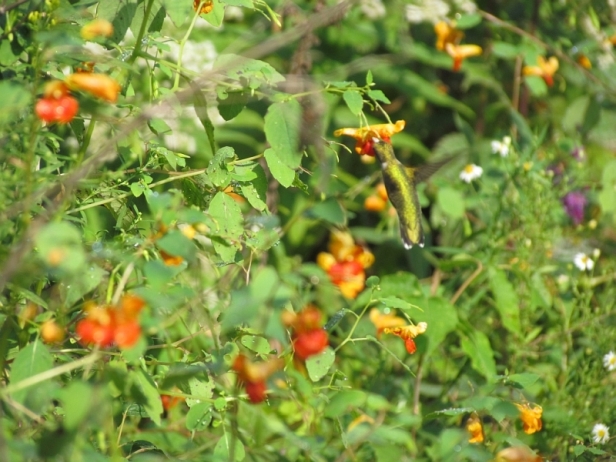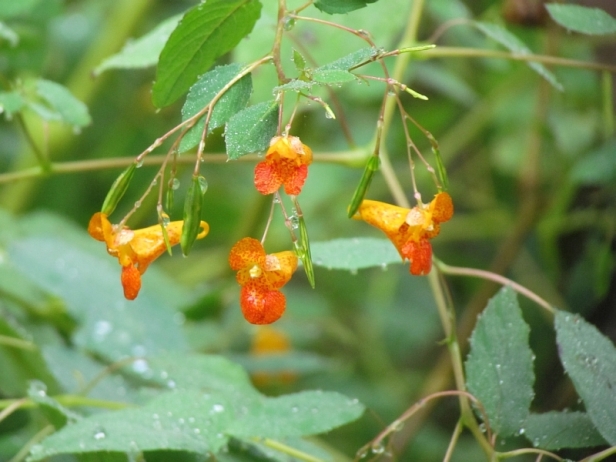Jewelweed
Other posts in the flowers of late summer series:
Today we’re going to look at a unique and special wildflower that blooms in late summer and early autumn. It tends to grow in colonies along wood edges or in woods openings or along forest paths where some sunlight filters through. It also grows along streams and wet areas, for it likes moist soil.
Bonus points for naming the 2 different species of white flowers in the above 2 pictures!
This wildflower is Jewelweed, a member of the Impatiens flower genus. This plant is also called Touch-Me-Not, in reference to its seed pods exploding outwards when touched.
The flowers are unique delicate-looking capsules that attract pollination by bees and hummingbirds. They hang from the stems of the plant. I’ve seen many a hummingbird sipping from these flowers…here’s some pictures of that happening:
The leaves of Jewelweed are easy to identify, long before the flowers bloom. They are symmetrical, ribbed and coarsely toothed. When wet, the leaves take on an almost silvery sheen. This bushy wildflower grows up to 5 feet tall.
There is more than one color of Jewelweed. Orange and yellow are the most common colors. I can’t quite say why one color is in one place while the other color is in another place, other than the distribution seems to be random. Overall, I see more orange than yellow.
There is a rare pale color (whitish) as well. I’ve only seen one patch of this color before.
Jewelweed has been used in remedies to help soothe skin rashes and mosquito bites, though studies haven’t confirmed its efficacy.
Jewelweed can be found in most states in the US. If you find some, study it for a while. It’s one of the more interesting wildflowers out there.















Lovely. And I am such a sucker for a nice hummingbird!
When I come across Jewelweed Inger, I look for hummingbirds- they love it!
We’re going to start looking for “hummers” when we see Jewelweed!
I see them around Jewelweed a fair amount of the time Robert- the blooms seem made for them!
My dad always told me it would cure a poison ivy rash too. Which is lovely because they often grow near each other. Queen Anne’s Lace or wild carrot is one of those white flowers. Is the other Boneset?
Poison Ivy rash is nasty stuff- I hope it works on that!
You’re 100% correct on Queen Anne’s Lace- good guess on the Boneset but it’s another white wildflower seen in the late summer/early autumn that looks a lot like Boneset 🙂
Yes. I have it all over my back yard; I’ve left it because I love how it makes the yard look woodsy against the trees, but I never have looked it up to see what it is. Now I feel foolish for not having done so!
I love to explode the little seed pods.
I’ve got to start doing that, Pat!
Hmm. Might that other flower be white snakeroot ? In which case it is poisonous to livestock. The deer certainly don’t eat it. They eat my roses and hostas instead.
That’s it! You got it! 🙂
Jewelweed is my favorite, and it’s done great in southeastern PA this summer, blooming right now amid the lovely complement of white snakeroot. But I’ve never seen the whitish flowers of jewelweed before. Really cool! And great shot of the hummingbird — I know they don’t stay at any one flower for too long.
Thanks, Scott! Glad you had a good Jewelweed year! This flower has tons of character and it’s always good to see.